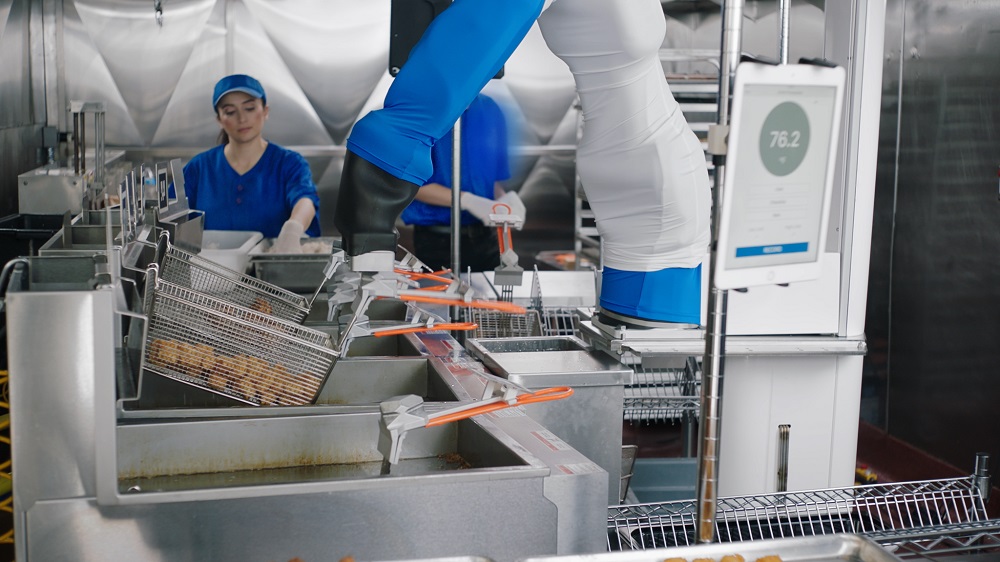Whether or not robotics will play into the future of the food industry is no longer a question. The technology is being implemented out in the field in the form mechanical produce pickers on farms and autonomous vehicles delivering food out on the streets. It’s also being used behind the scenes in the food industry, flipping burgers and frying chicken in restaurants, and picking and fulfilling e-commerce orders in supermarket warehouses. On the consumer-facing end, it’s delivering orders in restaurants, making coffee in coffee shops and baking bread in supermarket bakeries.
Now that the technology is here and being put to use, the question of if and when surrounding robots has now become why and how, and inventors and start-ups of all sizes are addressing challenges head-on in order to capture opportunities to provide solutions in an economonically pressured, ever-evolving world of food.
In order to succeed, especially in a slow-to-adopt industry, robots must add value, whether it’s in the supply chain or to the consumer, industry experts agreed at ArticulATE, a food robotics summit held in San Francisco last week.
Randall Wilkinson, CEO of Walla Walla, Wash.-based Wilkinson Baking Company, which created the BreadBot, a fully autonomous bread making machine found in supermarkets, pointed out that in his business, when you take a look at the costs involved in producing and distributing bread, it can be a costly endeavor.
“When you have this entire supply chain, the question is, what is my contribution to that supply chain? What am I making more efficient in that chain?” he said at ArticulATE. “Many of the contributions being made are in labor reduction, which is significant, but in our case, the actual offset that we’re looking at is all the plant and equipment costs of the factory…all of the labor costs of the factory, the fleet, fuel and distribution costs — when you have a value proposition that addresses as many slices of that value chain as you can, I think it strengthens the case for the role of automation.”
Not only should the adopter believe that the technology is relevant, it must also be helpful for employees that have to work with it and customers need to love it as well, said John Ha, CEO of Bear Robotics, which created Penny, a robot that can act as a server in the front-of-house in restaurants and hospitality scenarios.
“The overall restaurant industry is very conservative and their decision making is slow,” Ha said. “We saw in the early days when POS first appeared, adoption was slow, but suddenly, people realized that it truly helped the operations, and the adoption went up very quickly.”
LInda Pouliot, CEO of Dishcraft agreed, saying her company’s approach is to ask where can it can provide the most value in the back-of-house in commercial kitchens, and create products from there.
“In hospitality, it’s a close knit group of people who know each other so once you delight a few, our goal is that people will love it so much that they’ll tell everyone that they must adopt this,” she said.
At Creator, a burger restaurant in San Francisco that uses robots to build the perfect burger, the value is seen by the consumers since it’s able to make $6 burgers that keep up with taste and quality expectations at the same time.
“At the end of the day, our goal is not to be the world’s most automated restaurant, our goal is not to have as few people as possible — the goal is to have the best experience possible, and sometimes that means automating things,” said Alex Vardakostas, CEO of Creator. Vardakostas added that he highly values freeing up humans for roles that are more social or creative, which is part of the reason why order-taking was not automated at Creator.
Miso Robotics is also trying to free the kitchen from repetitive tasks and figure out ways to automate many aspects of the kitchen. It started with Flippy, its hamburger flipper, which Caliburger started using in its locations last year, and most recently just signed a deal with Compass Group to implement its upgraded robots to operate fryers alongside human employees at Chick ‘n Tots at Dodger Stadium.
“There is no world in 15 years that no part of our food chain isn’t automated,” said David Zito, CEO of Miso Robotics. “The key is getting utilization ratios right — today restaurant operators are squeezed on all sides.”
An important point that Zito mentioned to illustrate the opportunity of robotics in the food industry is that turnover in restaurants is at an all time high with people who would normally be working in those positions either flipping burgers, frying food or washing dishes opting to become Uber or Lyft drivers instead. Still, in order to meet demand for food in the next 10 years, 6 million more people — or 12 million more hands — will be needed, which represents a $10 trillion opportunity.
Not only can robotics help automate repetitive and dangerous tasks (i.e. frying), they can help make jobs at these restaurants more interesting for humans, and potentially even give those who work with robots in these environments a unique skill set for their resumes, he said.
While robots have yet to proliferate the way we engage with our food, there’s no denying that the future is now.
Related stories:
- How the gig economy is changing how restaurants hire, manage their workforce
- Restaurants turn to parties and perks to recruit, retain employees
- Creating an elevated experience at the intersection of food and entertainment
__________________________________________________
If you enjoyed this article, sign up for CIA ProChef SmartBrief, GMA SmartBrief, or Restaurant SmartBrief to get news like this in your inbox, or check out all of SmartBrief’s food and travel newsletters as we offer more than 30 newsletters covering the food and travel industries from restaurants, food retail and food manufacturing to business travel, the airline and hotel industries and gaming.
